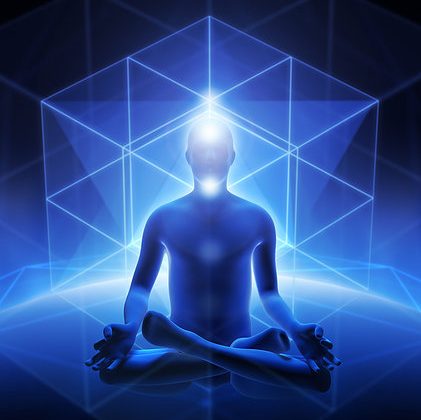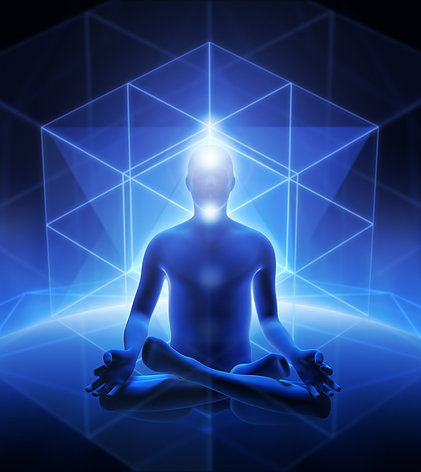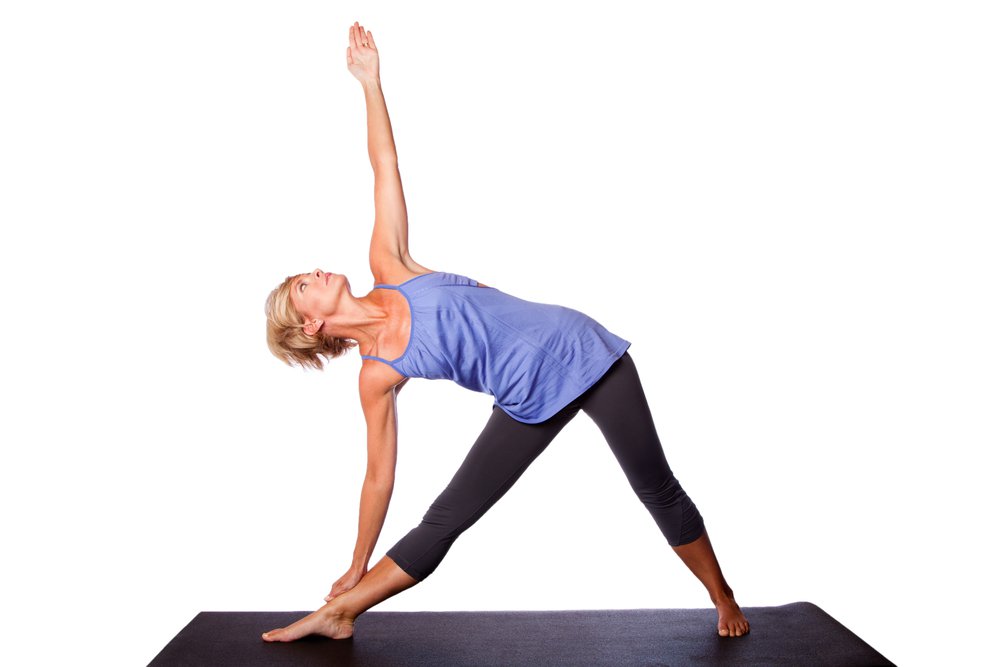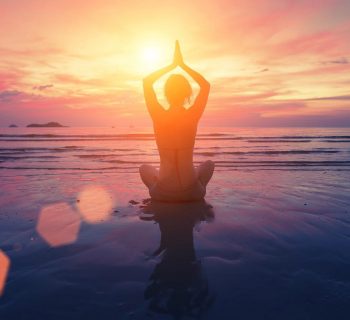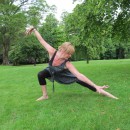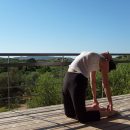Understanding Prakriti and Purusha
Since the kleshas are created by a persistent error in our thinking, at root mistaking Prakriti for Purusha or attributing the essential characteristics of Purusha to one or another aspect of Parkriti, they can be eliminated only by a radical reversal of our misapprehension. This fundamental correction is dhyana, meditation, together with the mental and moral exercises which strengthen it of which Hatha yoga is a part.
The concepts of Prakriti and Pursha are quite complex. Trying to keep things as simple as possible everything in reality can be considered to be a combination of these two. Purusha and Prakriti are essentially the witness and the object of all experience, known in the Bhagavad Gita as “The field and the Knower of the field.” Understanding and contemplating this essential duality is part of what Hatha Yoga practice is about. It is in experiencing and integrating dualities that leads us to the awareness of oneness, which is our spiritual freedom.
Prakriti is the primordial substance of the world, the creative energy of the absolute, the ever changing material realm. It is the primal matter with is composed of three different innate qualities, the guṇas, tamas, rajas and sattva.
- Tamas is a state of darkness, inertia, inactivity and materiality. Tamas is said to manifest from ignorance and deludes all beings from their spiritual truths.
- Rajas is a state of energy, action, change and movement. The nature of rajas is of attraction, longing and attachment and rajas strongly binds us to the fruits of our work.
- Sattva is a state of harmony, balance, joy and intelligence. Sattva is the guna that yogis aspire towards as it reduces rajas and tamas and thus makes liberation possible.
In life everything is constant state of flux, everything is moving. All matter, even inanimate objects are composed of constant vibrations of subatomic particles thus all of nature is in a perpetual state of movement and every state is temporary. Ancient yogic seers understood the eternal state of movement and also realised that there is also something permanent, timeless, and unchanging in contrast to all the change. They proposed that the unchanging constant is light a theory that has since been confirmed by physics. It is the eternal, effortlessly aware light of inner Self: Purusha.
Purusha as discussed earlier in this article is pure consciousness. It is the formless knower or the witness, the transcendental Self. It is absolute, independent, free, imperceptible, unknowable, above any experience and beyond any words or explanation.
Prakriti by contrast is devoid of consciousness, it is unintelligible and gets greatly influenced by the Purusha, the self.
An analogy of the Purusha/Prakriti principle is that of watching a film at the cinema. The story/drama unfolds upon the screen as we watch it. Most of us become completely absorbed and emotionally involved in the plots of the story as they unfold, we are completely captivated. What we are watching upon the screen is however is a single, neutral, bright light in the projector. The film passing in front of the light is like Prakriti, and the light, is Purusha. The combination of the two projects the story.
Human suffering comes from identifying with temporary forms rather than with the eternally witnessing Purusha. All limbs of yoga develop the ability of the practitioner to turn within to perceive the inner light within ourselves. This requires a refinement of our awareness and work to bring blance, harmony and equilibrium to the body/mind, to quieten down the nervous system, cleanse it of distortions, and allow the Self to reveal itself.
Using the analogy above, if we were at the cinema and the film suddenly stopped projecting onto the screen, most of us would turn around to find out what the problem was. It is the same in our yoga practice we ‘stop’ or minimise the fluctuating action of the mind, which automatically turns the attention around to the witness of the body/mind. This is when the Subject becomes the Object and there occurs the integration of the two principles.
Meditation practice to overcome the kelshas
Initially we need to acknowledge the kleshas existence. A full outline of the kelshas is given in part one of this article. Reflection promotes self awareness, self understanding and self knowledge to uncover and see the kleshas and their roots as well as how they create suffering in our lives.
In 2.10-11, Patanjali tells us that the afflictions may be subtle or gross. To reduce or eliminate the subtle afflictions i.e. the dormant and feeble afflictions, we have to reverse the energy of the thought responsible for each affliction back to its source or cause in the ego. The conscious state of mind is the only state where conflict, pain and suffering arise. In the unconscious or subconscious state of mindstuff, these afflictions remain without any conflict. In this un-manifested state they cannot disturb mindstuff hence by reverse propagation one should resolve them into their causal state. The self goes into the Self and the mindstuff goes back to Parkriti. Human effort cannot overcome them because their real form is not on the level of the conscious state of mindstuff.
This inverse propagation involves the mechanism of repression and suppression known to modern psychotherapy. These samskaras can be transformed by resolving the individual mind into its cause, cosmic mind by means of the light of Purusha. By knowledge of Purusha the whole mind can be enlightened and all samskaras can be rooted out. We purify it with its own true opposite, for example, if a feeling of attraction or repulsion arises; substitute it with contentment or acceptance. Resolving the obstacles to their original cause refers to the experience of Self realisation in which the mind is transcended and ignorance eradicated. Since ignorance gave birth to the obstacles and sustains them when it is dispelled by the light of the Self the obstacles can no longer exist.
The gross and outward expressions of the 5 kleshas, that is those referred to as intercepted or sustained, can be silenced through meditation which averts awareness away from the obstacles which will gradually wither through lack of attention. In the practice of meditation they are not allowed into the field of consciousness and memory so they return to the unconscious or subconscious mind where they remain in seed form. When their seed form is also burnt up by Samadhi,t he mind becomes completely free of them.
In addition in 2.26 Patanjali presents another remedy in the form of unwavering practice of uninterrupted awareness, discriminating between what is real and what is unreal. This is a means to remove ignorance. In sutras 2.27-8 he then tells us that the impurities of the mind are diminished and that we can attain the highest stage of enlightenment through the dedicated practice of the seven limbs of yoga (Samadhi being the 8th limb)
We are warned in 2.12 that if these afflictions are not destroyed they will be stored in the unconscious state of the mindstuff and will be the cause of suffering in this life or the next
The kleshas if not dealt with, form a persisting matrix of karma, the results of which must eventually be experienced either in this lifetime or in a future incarnation. Karma creates mental deposits, seeds, which channel mental energies into repeatedly reinforcing the kleshas. All karma brings pain and suffering, including the pain of loss and gain, growth and decay. Dhyana can effectively eradicate these mental deposits while providing the clear detachment (vairagya) and patience (kshanti) to exhaust and dissolve the karmic matrix over time.
As long as the kleshas remain, involuntary incarnation into bodies subject to the pleasure pain principle is unavoidable. Such embodiment results in an inevitable fluctuation of happiness and depression. These are the product of egoism and the polarity of attraction and aversion, rooted in ignorance and resulting in the clinging to bodily life. The yogi through sadhana comes to see that the truth of spiritual freedom transcends the kleshas entirely. The power of intention and simply keeping in mind the intention to practice and live free from these obstacles will hold enormous power. Regular commitment to practice is the key.
I feel the The Bhagavad Gita reinforces so much of what is found in the sutras,5.19-25 I believe many aspects previously discussed are raised in the following excerpt
“Those who possess this wisdom have equal regard for all. They see the same Self in a spiritual aspirant and an outcaste, in an elephant, a cow and a dog. Such people have mastered life. With even mind they rest in Brahman, who is perfect and is everywhere the same. They are not elated by good fortune nor depressed by bad (raga and dvesha). With the mind established in Brahman, they are free from delusion (avidya). Not dependent on any external support, they realise the joy of spiritual awareness. With consciousness unified through meditation (sutra 2.11) they live in abiding joy. Pleasures conceived in the world of senses have a beginning and a need and give birth to misery. The wise do not look for happiness in them. But those who overcome the impulses of lust and anger which arise in the body and made whole and live in joy. They find their joy, their rest and their light completely within themselves. United with the Lord, they attain Nirvana in Brahman”
Yoga asana practice to overcome the kleshas
When we practice yoga we are simultaneously learning to withdraw our attention from the external distractions and sharpen our discernment of the witness consciousness. The purpose of yoga as a spiritual practice is to develop our relationship with the effortless aspect of ourselves which is beyond time and change. Contrary to how it may be understood Hatha yoga is not a practice that is meant to intensify our identification with the ever-changing body.
In Hatha Yoga we move our bodies in a way that promotes the perception of stillness within our being. We are moving to experience the inner stillness.
There are three places of attention in our yoga practice, known as the tristanam.
The breath is the first component of the tristanam of yoga practice. It is through the breath that the other 2 components, the body and mind are transformed. We cultivate our awareness to be able to notice the pause between the inhale and the exhale, that space between the space. In the Yoga Sutras Patanjali talks about finding infinity in the pauses of the breath, this is where the magic of yoga can unfold.
The breath is the link between the body, mind and soul. By bringing these into unison we achieve yoga, unity. In your practice I invite you to consciously choose to link the breath with the body allowing every movement to be led by the breath. Allow the poses to compliment the breath rather than sacrificing the breath for a posture, any time you are breathing correctly you are doing yoga just perfectly. Breathe space into the body. Pay attention to the breath, letting the mind become absorbed in the rhythm of the breath allowing the mind to become naturally drawn into the presence and the stillness within.
For more information on working with the breath see the ujayii breath article
Asana, literally meaning seat, translated as posture, is the 2nd component of the Tristanam, the body aspect. Asana is an opportunity to develop concentration, staying aware of breath, body and gaze as we hold the posture. Our practice literally becomes a moving meditation.
Hatha- literally means sun moon and is the practice of bringing balance to the breath, body and mind. Balance requires alignment, Alignment begins with foundation and should never place undue pressure on the breath. Each person has a unique structure, therefore there is no universal correct alignment. Some sense of alignment or centeredness in each posture is needed to effectively develop awareness. Alignment is simply the ability to balance the various levels of the body and mind into a working whole. It will strengthen the muscles and ligaments equally on both sides of the active joint creating balance in the body. Balance alleviates tension in both the body and mind. The basic principle of polarities is the essence of yoga- external- internal, earth-sky, front-back, strength- flexibility. Yoga enables us to work towards the resolution of polarities on a physical level. When you can hold your polarities unified in the present moment you will contact the self.
As we flow from one asana to the next we develop the skill of staying balanced/centered while navigating transitions which equips us for our everyday life. When we can cope with change and flow with change life becomes freer. Humans often suffer because we cling to things and resist change yet the only constant in life is change, nothing stays the same. Changes are necessary for our growth and evolution. The more we develop our identity with the neutral witness the easier it becomes to flow not just from one pose to another but also from one life experience to another. We cultivate the skill of staying centered while coping with transitions.
This reminds me of Rudyard Kipling poem If
If you can keep your head when all about you
Are losing theirs and blaming it on you,
If you can trust yourself when all men doubt you,
But make allowance for their doubting too….
http://www.familyfriendpoems.com/poem/if-by-rudyard-kipling
The third aspect of the tristanam of physical yoga is dristi which are gaze points, to focus the mind. Dristi means the looking place, literally means perception. By keeping the gaze focused on a dristi point, pratyahara, withdrawal of the mind takes place and eventually a new perception arises. Dristi preserves and directs energy, enhances alignment, deepens the pose and enhances concentration. Keeping your consciousness within the field of your body and this inner awareness will unfold and we concentrate on the breath.
Traditionally there are 9 dristi points in yoga these are:
- Nose- Nasagrai
- Upwards- Urdhva
- Third eye- Ajna chakra
- Hand- Hastagrai
- Thumbs- Angustha madyai
- Right side- Parsva
- Left side- Parsva
- Navel- Nabi
- Foot- Padayoragrai
